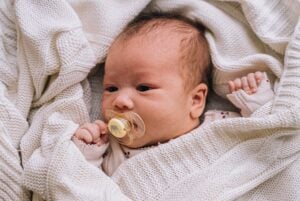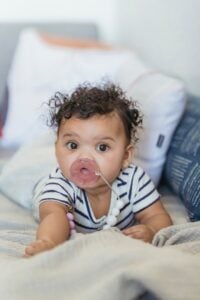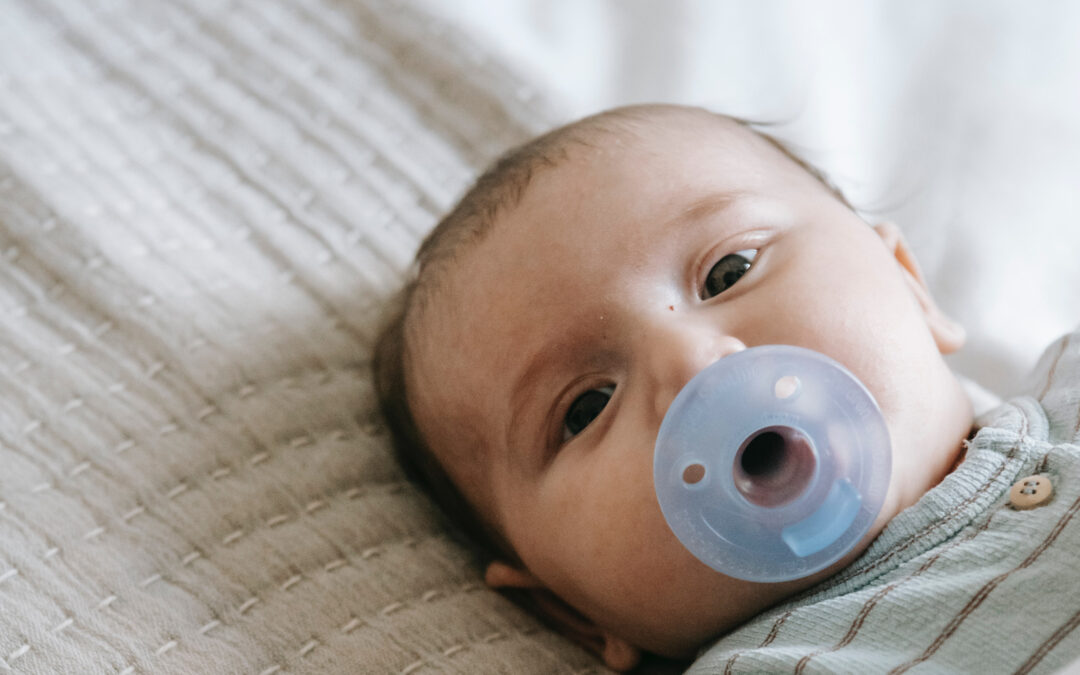Coming to you from Las Vegas with another baby sleep blog: A “Would You Rather” addition. Would you rather sleep train your baby and get great sleep? Or keep their beloved ride-or-die pacifier? I can’t decide what I would choose. Except, it’s definitely both. You may have heard that you have to drop the pacifier if you want to sleep train your baby. That babies can’t fall asleep independently if they are using a pacifier to soothe.
I am here to tell you that’s a bald-faced lie. Sleep training and pacifiers CAN go together like peanut butter and jelly, adulting and caffeine, and Rachel and Ross (with MUCH less drama). If this sounds too good to be true, then you’re going to want to read on to find out all my trips and tricks for letting your baby keep their soothing method of choice AND get the sleep they (and you!) need.
Why and When to Introduce a Pacifier

First off, I should be honest and admit that if it seems like I’m pro-pacifier, it’s because I am! As in, I am a pro at all things pacifier related AND believe they are beneficial. In my opinion, we want our babies to learn to self-soothe, and this will be easier if they have had practice being soothed by something other than you. You may have heard that offering nursing to comfort your baby is better than offering a pacifier.
Although comfort nursing can be great, it can also be super inconvenient at times (think car rides, caregivers, or anytime you and your boobs may not be available). Also, nursing to comfort can cause tummy issues; if they want to suck but are not hungry, they can get confused and all that extra milk can cause discomfort. I suggest tuning in and being mindful to know when comfort nursing is a good option and when offering a pacifier might be a better option.
Some people also wonder when the best time is to introduce the pacifier. You might have heard to wait until breastfeeding is established to not cause nipple confusion, however my recommendation is to introduce one right away. I think that nipple confusion is a much less common issue than waiting too long to introduce a pacifier and then having your baby refuse it. I also think it can help with their latch, as it’s easier to reposition them on the pacifier than it is on the breast.
If you’re trying to introduce the pacifier, and it’s straight up not working, I encourage you to stay consistent! It can take some babies a while to get the hang of it. Continue to offer it, even make a game of tickling their lips or gums with it to get your baby used to having it around their mouth and encourage them to suck on it. I also suggest trying different brands, as pacifiers come in lots of different shapes and sizes. Just make sure you are choosing an age appropriate size.
Sleeping Training with a Pacifier

Now on to sleep training with a pacifier. Many sleep consultants will tell you to drop the pacifier when sleep training, however I take a different approach.
I feel that we are already removing a pretty big piece of their soothing repertoire (YOU!) so we should let them hold onto the pacifier. Now, I’m sure you’ve already realized the pretty big predicament here; the optimal time to sleep train is 4-6 months, but your baby is as useless at putting their pacifier in their own mouth as your partner is at remembering the finely tuned, 18-step bedtime routine.
Luckily, I’ve got you covered. The solution is to sleep train your little one using my Modified CIO method. When you put your baby down for the night and start your timer, they will inevitably lose their pacifier (and then their bananas, of course). Wait for the end of the timer, and when you go in to soothe, pop the pacifier back in. It’s that easy! No, there’s no catch!
For most babies, you will only need to do this after the first timer. Some babies will even drop the pacifier during the sleep training process, however if you’re not the type of person that tends to have good luck in these situations, then your baby may stay dependent on it. That’s ok; keep popping in that pacifier when you go in to soothe at the end of the timers. Once your baby is sleep trained, your baby may fuss for 10-15 min before putting themselves to sleep, and you may have to go in to reinsert the pacifier for them.
I know this doesn’t exactly sound like your ideal evening, however it’s a short period of time where you do the pacifier yo-yo, until your baby is coordinated enough to put the pacifier back in their mouth. Since sleep training most often results in night wakings dropping on their own, you should not be up all night putting the pacifier back in their mouth. If this IS the situation you find yourself in, and your little one IS waking all night long, expecting you to be their personal pacifier butler, then it may be time to drop it. There’s more on dropping the pacifier below.
Nap Sleep Training with Pacifiers
If your baby is waking up early from a nap and wants their pacifier back, then you can give them some time to fuss and see if they will put themselves back to sleep before going in to reinsert it. Or, if this becoming a recurring nap theme, you can go in as soon as they start stirring, to pop the pacifier back in before they fully wake up.
Once your baby is a little older and can navigate finding their missing pacifier and putting it back in their own mouth, you can scatter a few pacifiers around the crib. This way, you can optimize the likelihood that they will be able to locate said pacifier on their own. You can also help them learn to get the pacifier back in their mouth; run an amateur baby boot camp during tummy time; dangle it around their head and by their hands, play peek-a-boo with it, basically get creative to help them build the strength and skills they need.

Dropping the Pacifier
If you want to drop the pacifier, I suggest doing so before 6 months or after 2 years, since between 6 months and 2 years babies are usually as attached to it as you are to your morning caffeine fix.
If keeping the pacifier during that 1.5 year window isn’t working for you, I have a super helpful Pacifier Troubleshooting Guide in my 4-24 months guide pack that walks you through it.
Sleep Training & Pacifiers Next Steps
There you have it! The secret is out; you can rejoice at the fact that you have one less thing to stress about on your never-ending, dictionary sized list of things that keep you up at night.
And on that note, for all the information you need to start sleeping through the night again, check out my Sleep Training Essentials Course where I walk you through how to sleep train your little one.
Let me know in the comments how it goes for you!

